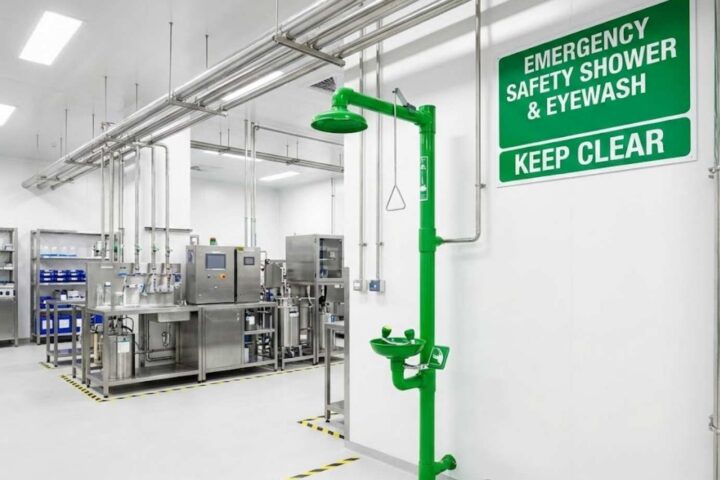Key Takeaways:
- OSHA guidelines differ for fall protection in the general industry and construction industry.
- There is no minimum height rule when working over dangerous equipment or machinery.
- Various exceptions exist, particularly in the construction industry including for scaffolding, steel erections, stairs, ladders, and vertical rebar assemblies.
- Understanding and implementing appropriate fall protection measures is vital for ensuring workplace safety.
Understanding Fall Protection: The Foundation of Workplace Safety
The fundamental question asked by safety professionals across different industries is: “At what height is fall protection required?” While it would be easier to enforce a uniform height requirement across all tasks and industries, the reality is far more complex. Different tasks, environments, and industries require specific safety measures, and the Occupational Safety and Health Administration (OSHA) aims to provide guidelines that keep people safe in various contexts. However, local building codes such as Cal-OSHA, contracts, and/or site policies can exceed these regulatory requirements.
Distinguishing Between General Industry and Construction
OSHA specifies different height thresholds for requiring fall protection in general industry and construction:
- General industry requires fall protection for any worker over 4 feet according to 1910.28(b)(1)(i).
- Construction, however, requires fall protection for any worker over 6 feet as per 1926.501(b)(1).
These regulations mandate the use of fall protection whenever employees are exposed to heights equal to or greater than these specified thresholds. The goal is to reduce the risk of falling from height, which is addressed by fall safety solutions such as railings or personal protective equipment like harnesses, lanyards, and lifelines when railings are not feasible.
The ‘No Minimum Height’ Rule
OSHA’s guidelines include a ‘no minimum height’ rule applicable when workers are performing tasks over dangerous machinery, equipment, or any other hazard. In these circumstances, workers must have fall protection at all times, or alternatively, machine guarding needs to be put into place to prevent accidents.
Understanding the Exceptions: Diving Deeper into the Construction Industry
The construction industry presents unique challenges due to its dynamic nature, making it difficult to both identify fall hazards and install permanent fall protection systems. Consequently, OSHA has approved a number of exceptions specific to this industry. Understanding these exceptions related to scaffolding, steel erections, stairs, ladders, and vertical rebar assemblies is essential to ensuring workplace safety.
Scaffolding: Building Up Safety
According to Subpart L of the Construction regulations, specifically 1926.451(g)(1), fall protection on scaffolding isn’t mandated until a height greater than 10 feet off the lower level is reached. This allowance means that users aren’t required to implement fall protection every time they set up a single bay or level of scaffolding, making work on top of a single bay of scaffolding possible without the need for fall protection.
Steel Erection: Navigating Complexities
The Steel Erection regulations, known as Subpart R of the Construction standards, are renowned for their leniency and complexity. Simply put, those involved in steel erection activities aren’t required to use fall protection until they are 15 feet in the air. This rule gets more intricate with connectors – the crew members who receive and connect steel members. They are not required to be tied off up to 30 feet or two stories, whichever is less. However, they must wear proper fall protection equipment and have an approved anchor point after 15 feet. It is crucial to note that the ‘or two stories, whichever is less’ clause can require connectors to be tied off at, for example, 24 feet, if it’s two stories of 12 feet each. This rule emphasizes the need for understanding and adapting to specific regulations based on the context.
Stairs and Ladders: Unseen Hazards
Fall protection requirements for stairs and ladders are often overlooked, perhaps because stairwells are frequently enclosed or already equipped with some type of railing. Nevertheless, OSHA’s Subpart X, 1926.1052(c)(12), necessitates that all stairways having four or more risers, or rising more than 30 inches, be equipped with a stair rail along each unprotected side or edge. This is a crucial rule to remember, especially since stairs, whether permanent or temporary, are frequently constructed on job-sites without the railings or walls that will eventually enclose them.
When it comes to ladders, fall protection must be provided in any instance where the climb on a fixed ladder is greater than 24 feet, or where the climb is less than 24 feet but the top of the ladder is more than 24 feet above a lower level. This fall protection can take the form of a ladder safety device or a self-retracting lifeline. For extension ladders, three key considerations are a 3-foot extension past the level being climbed, a 4:1 ratio of rise and run, and maintaining three points of contact with the ladder at all times.
Climbing Vertical Rebar Assemblies
OSHA has provided specific guidelines for employees climbing vertical rebar assemblies, such as those constructed for walls that are to be poured in place. The agency stated in a letter of interpretation dated May 19, 1997, that fall protection isn’t required while the employees are in motion up to 24 feet, as the multiple handholds and footholds of a vertical rebar assembly provide similar protection to that of a ladder. However, if an employee needs to climb to a height greater than 24 feet, they would need to utilize fall protection.
Conclusion: Prioritizing Safety at All Heights
There’s no one-size-fits-all answer when it comes to fall protection. Each situation requires an understanding of the applicable standard and a safety plan that revolves around the work being done. Despite the complexities, one principle remains constant: when it comes to working at heights, you can never be too safe. Ensuring an understanding and application of fall protection measures at all heights is paramount for maintaining a safe work environment.








